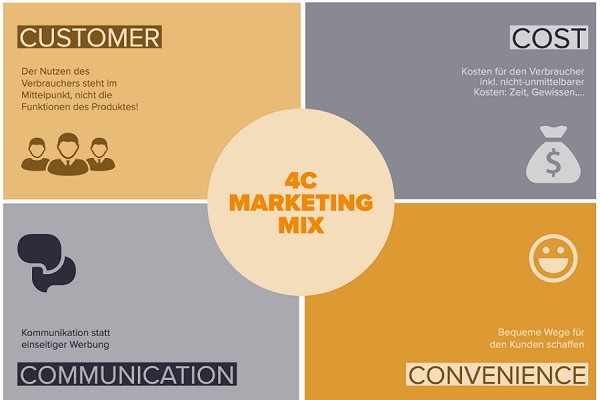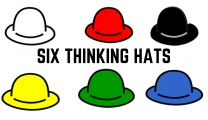1. What is the 4C model in Marketing?
The 4P in the Marketing mix is considered an immortal model applied by companies when implementing marketing strategies. However, in the context of the market trend shifting to 4.0 and the digital transformation revolution in marketing, this model clearly reveals many shortcomings when it is too focused on products.
This is understandable since the 4P concept was developed during the “push” marketing era, where the product was created by the business and then brought to the market to the consumer who had to be convinced that they want and need it.
In today's customer-driven environment, businesses are starting to take a "pull" approach, with products created to fit the needs of their customers. This was the impetus that led Robert F. Lauterborn to develop the 4C model in 1990 after he declared the traditional 4P method obsolete.
4C in Marketing includes 4 elements: Customer, Cost, Convenience and Communication. Lauterborn's 4C model, with its customer-centric orientation, has moved the marketing problem from mass media marketing to niche marketing. When implementing a niche marketing strategy, companies can determine exactly who their customers are and focus on solving the needs of that customer.
2. 4 elements in the 4C . model

2.1. Customer Solutions – Solutions for customers
First of all, the 4C strategy focuses on Customer Solutions. That is, each product launched into the market must be an effective solution to help customers solve their problems and meet their needs, not just a tool to help businesses make profits. This factor requires businesses to deeply understand their target customers, listen to their needs and touch their pain points to focus on solving customer problems.
To meet Customer Solutions, businesses need to ensure the following factors:
- Correctly identify and hit the target customer file
- Hear feedback and advice from consumers
- Be proactive in providing value to customers
2.2. Customer Cost – The cost customers spend
The second C in Lauterborn's model is Customer Cost, which refers to the amount the customer has to pay for the product. The cost here is not only encapsulated in the product price, but also all the costs incurred for use, transportation, maintenance, ... and opportunity costs. Setting costs to both optimize profits for businesses and ensure benefits for customers is a very important thing.
To solve the cost problem, businesses need:
- Choose the right product pricing method
- Research the total cost customers will have to spend on the product
- Determine the buyer's cost sensitivity
- Research the costs of competitors and similar products
2.3. Convenience – Convenience
Convenience – Customer convenience is the 3rd factor in the 4C Marketing model. This is a key factor in customer decision making. The mission of the business is to remove all barriers that hinder customers when they access the product.
This process includes:
- Identify barriers that prevent customers from learning and purchasing products
- Find solutions to overcome obstacles
- Build a multi-channel sales system so that customers can easily find products in any distribution channel
2.4. Communication – Communication
The last factor, Communication - Communication is the key factor to maintain relationships and retain customers. Communication requires a two-way interaction between the seller and the buyer. This is a process that takes place throughout before, during and after a customer makes a purchase. With the development of the Internet, businesses can now easily communicate and take care of customers on online platforms.
The Communication element requires companies to:
- Always listen to customer feedback and take suggestions
- Support customers whenever they need
- Communicate and update the latest news about products and businesses in a timely manner to customers
3. The combination of 4Cs and 4Ps in marketing
3.1. Customer – Product
This combination means that any product created must be the solution to the problem of customer needs. The use of the product must thoroughly solve the customer's problem. To achieve this, companies need to research customers thoroughly to create products and services that closely match the needs of customers.
3.2. Cost – Price
The price that the business offers must be commensurate with the cost that the customer spends for the product. The customer's investment should be commensurate with the value they receive in using the product.
3.3. Convenience – Place
The product distribution location must have a supporting role for the customer's product access process to go smoothly. Companies need to focus on optimizing distribution channels by considering where customers shop most often.
3.4. Communication – Promotion
Marketing communication is the shortest way for companies to "dialogue" with customers. Communication and advertising channels provide businesses with resources and means to interact with customers through promotions, advertising campaigns, discounts, etc. These interactions help companies and customers understand each other. Moreover, the business-customer relationship is strengthened, corporate brand reputation is enhanced.
=> The combination of 2 models 4C and 4P will create a strong product and customer-oriented vision, helping to increase customer satisfaction, brand awareness, revenue and profit for customers. enterprise.












Replies to This Discussion